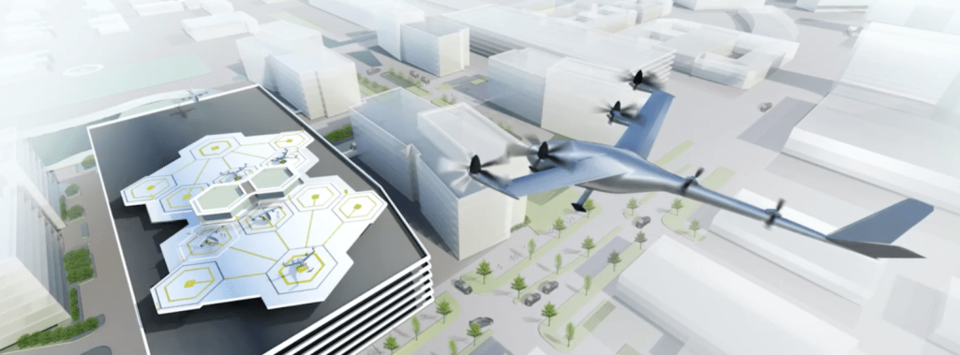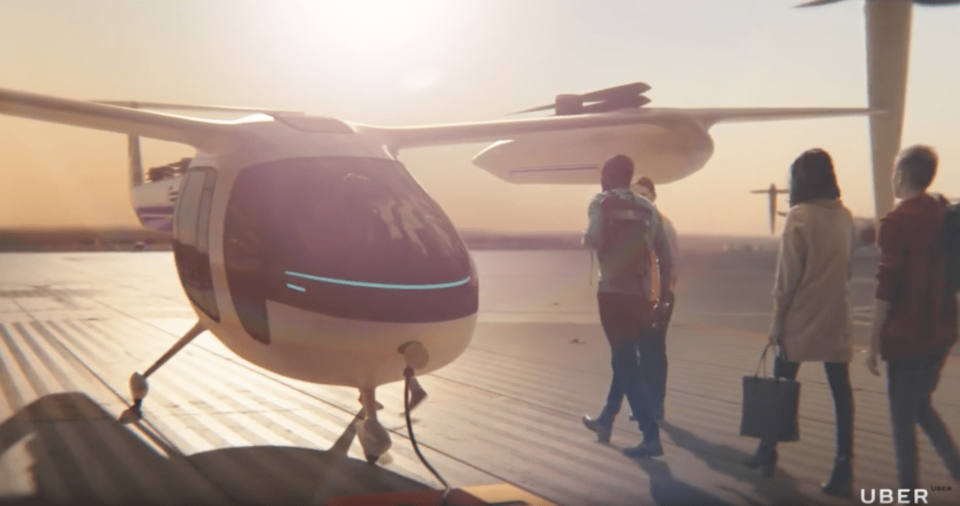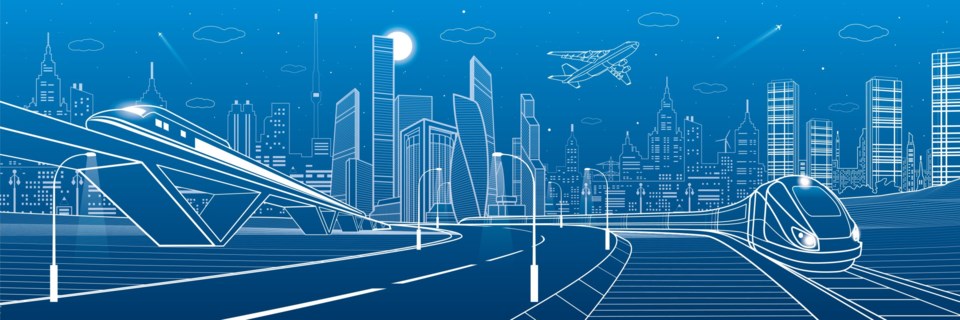The year is 2030. Its 7 a.m. on Interstate 75 as the people of Collin County make their way to work and school. They sit in the driver’s seat of their cars, but they are not the drivers—the cars drive themselves. Overhead, flying objects buzz across the sunrise. They, too, are carrying individuals headed to work, to school, and perhaps—for the lucky ones—to the airport for vacation.
Back on the ground in Plano, Dianne wakes up her 10-year-old son, Braxton, and finally manages to get him dressed and out the door. Braxton hops into the back seat of the four-door sedan and fastens his seatbelt while Dianne slides into the driver’s seat and pulls out a book. They read together every morning on their way to Braxton’s elementary school. Dianne’s hands are free to turn the pages as their car drives itself in autonomous mode. She and Braxton laugh at The Diary of a Wimpy Kid while the car tires spin. When they arrive at school, Braxton bounces out, slings on his backpack and waves goodbye to his mom.
Dianne is off to work now. Her car knows the route to her downtown Dallas office and gets her there safely and at a consistent time every day. It is now 8 a.m., and Dianne has a morning meeting in Fort Worth. After preparing some notes and gathering her things, she meets her coworkers on the roof of the parking garage.
There are no parking spaces at the top of the garage. Instead, there are three Vertiports—helicopter pad-like areas reserved for electronic vertical takeoff and landing vehicles (eVTOLs). These are the same vehicles that carried commuters through the sky to their desired destinations earlier in the morning. After boarding the eVTOL that’s waiting for them, they touch down in Fort Worth less than 10 minutes later. They meet with clients in a nearby office building before heading back to Dallas via the same eVTOL. The entire journey takes less than an hour.

At 5 p.m., Dianne gets back into her car and heads home. Because eVTOLs have taken many road commuters into the sky, rush hour traffic is a thing of the past. Dianne arrives home in about 20 minutes. In autonomous mode, her sedan pulls into her driveway and parks itself.
Though this story is fiction, it’s based on the vision of companies like Uber and Toyota. These transportation experts are preparing for the future of transit in the Dallas/Fort Worth region, and according to them, Dianne’s day could very closely resemble the average workday in just 10 or 20 years. There are a bevy of new technologies being developed and tested right now that will change the way we get around in the near future—autonomous vehicles, eVTOLs, and high speed trains are just a few.
Roads
There is much hype about autonomous vehicles, but there are many phases of vehicle autonomy to work through before you’ll see any cars rolling by without humans sitting in what is currently referred to as the driver’s seat. According to the National Highway Traffic Safety Administration, there are six levels of vehicle autonomy. These levels range from no automation (Level 0) and driver assistance (Level 1) with functions like cruise control and lane guidance, to high automation (Level 4) and full automation (Level 5) with the vehicle performing all driving functions and monitoring surroundings on its own.
The development of vehicle autonomy technologies has forced many long-standing companies to think outside of their normal business scope. Toyota is joining the hype, though Corporate Communications Manager Victor Vanov says the company is still “many years” away from full vehicle autonomy. The company is still in the beginning stages and is currently working on Level 2 vehicle autonomy in their Michigan Research and Development Center.
Since human safety is a concern, there are many areas of development to be considered. What if some cars on the road are autonomous and others are not? How will they interact? Vanov says that there needs to be a greater discussion among automakers to determine one set of standards on how autonomous vehicles communicate with each other, with human drivers, and with infrastructure.
“In 10 years, you’re still going to have folks who drive to work on their own,” Vanov says. “And decades from now, you will have autonomous vehicles on the road. Our view is that you need the driver to be engaged and alert at all times. The vehicles can’t necessarily be fully autonomous. People need to be there to help guide the car.”
Uber is another company leading the charge in transportation innovation. External Affairs Manager for Texas, Arkansas and Oklahoma Leandre Johns says the company is excited about new technologies that will change the way we travel.
“We know that autonomous vehicles are coming and that they are the future of transportation,” Johns said.
In 2016, Uber began testing their autonomous vehicles in Pittsburgh and then in Phoenix soon after. These vehicles have a human driver behind the wheel as a safeguard, but they’re just back up. The cars drive themselves on state roads alongside vehicles driven by actual humans. Uber’s Toronto-based cyber-research and engineering facility and their San Francisco-based advanced technology center are highly focused on experimenting and producing autonomous vehicles, with the plan to bring these vehicles to all markets, including Collin County and the rest of DFW.
In Phoenix and Pittsburgh, hailing yourself an autonomous ride from Uber currently looks like this: Open your Uber app and choose the self-driving Uber option. One of Uber’s autonomous vehicles will pull up with a driver who has the ability to take over at any time. In the backseat is an iPad that shows you what the car is actually seeing. Your trip proceeds as usual and the car rolls to a stop when you have reached your destination.
In 10 years, riders in Collin County and greater DFW will likely have the choice of taking an autonomous Uber or an Uber with a human driver. Johns says those who are most concerned with safety could opt for the autonomous vehicle, as they will be programmed to be top-notch defensive drivers with safety as an unwavering first priority. Someone who is running late to catch a flight may opt for a human driver who can get them there more quickly.
There are many challenges around autonomous vehicles that need to be overcome, however, before these robot cars will be considered as the norm, and Uber says that we won’t see an overnight switch to autonomous vehicles rolling around on every street. With any new piece of technology—especially something as forward-thinking as self-driving vehicles—comes a period of trial and error and of warming people up to it. This was evidenced by the fatal accident involving a pedestrian and one of Uber’s autonomous vehicles in March of this year. Since the accident, Uber has pulled all of its self-driving cars off of the roads until an investigation is complete.
“Cars are like babies,” Johns said. “They need time to grow up and learn before they can make the same decisions that humans can make on the street.”
Skies
Perhaps one of the most innovative forms of transportation technology hits close to home as Uber named Dallas the pilot city for their new venture, Uber Elevate. Uber Elevate is an extension of the Uber we know, but these rides will fly. Uber Elevate will use eVTOLs to carry passengers from one place to the next. These vehicles will be a hybrid of an airplane and a helicopter, taking on an appearance similar to the latter. Using Distributed Electric Propulsion technology, these vehicles can take off from a set position, like a helicopter, without requiring an overhead rotor.
Though this new method of transportation seems to be straight out of a futuristic sci-fi movie, its arrival is just under five years away. Dallas will see the launch of commercial flights on Uber Elevate that are available for anyone to take in 2023, with test flights beginning in the region as early as 2020.
Sometime in the next decade, what is now an inconvenient 45 minute haul from Dallas to Fort Worth or Dallas to Frisco will be completed via Uber Elevate in around 10 to 15 minutes. The idea is that flying vehicles can increase efficiency and a person’s productivity while decreasing congestion on our roads.
The introduction of Uber Elevate brings forward the necessity for multi-modal trips—these eVTOLs won’t land in your backyard. Instead, they will land on Vertiports scattered throughout each city. Picture this: You open your Uber app and select Uber Elevate, which then plots your course to the nearest Vertiport. If you’re downtown and you can walk, your app will direct you to walk in the right direction. If the nearest Vertiport is not within walking distance, an Uber car will be sent to pick you up and drive you to it. When you’ve completed your eVTOL trip and landed at your destination, an Uber vehicle will be waiting to take you to your front door (or wherever your final destination may be).
“We are so excited about what it means for the future of transportation, because now we are talking about the third dimension—we are going up a level,” Johns said.

Rails
The Texas Bullet Train, developed by Texas Central, will bring yet another option to travelers in DFW and Collin County. This high-speed rail service connecting North Texas, the Brazos Valley and Houston could be running as early as 2024. With nearly 50,000 Texans traveling back and forth more than once a week between the two regions, the 240-mile train line will offer a total travel time of less than 90 minutes.
Each of these transportation methods are communicating with each other and looking at different ways that their respective technologies can integrate. In 20 years, a businessman from Plano may jump into an autonomous Uber vehicle and head to the Texas Bullet Train station to catch a train to Houston for a week of work, or even for an afternoon meeting. There could be various points of integration within apps that help to sync these modes of transportation to make multi-modal trips easier for those taking them.
Uber’s Leandre Johns thinks that in 10 years we will see a mix of many new types of transportation in DFW and Collin County, including the high speed rail. He also thinks that Dallas may become more walker- and biker-friendly as we see an increase in the number of people opting for bikes as a method of transportation.
“Of course I think you will see some form of autonomous vehicles on the streets in Dallas,” Johns said. “I think that is going to bring some efficiency in travel.”
He also envisions eVTOLS flying around the city as people opt to take this new third vector of transportation as an option for getting from point A to point B.
“I think in 20 years you will see all of this but much more fluid … Much more proliferation of each of these new technologies,” Johns said. “But what I think you will see the most of is a change in our cities. I think you will see rural and urban get closer than they have ever been before.”
Originally published in Plano Profile‘s May 2018 issue under the title “Tomorrowland – Navigating the Future of transportation in DFW”.




